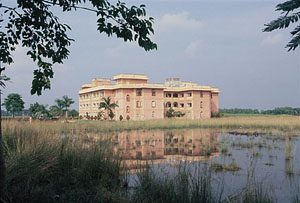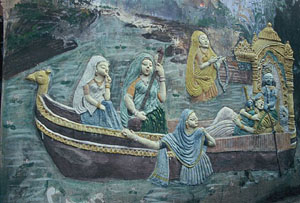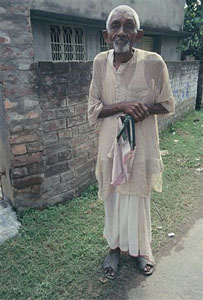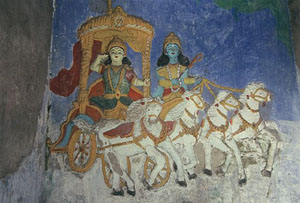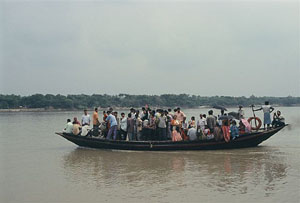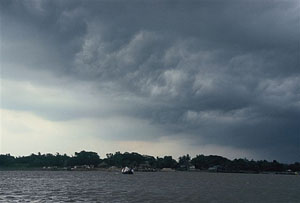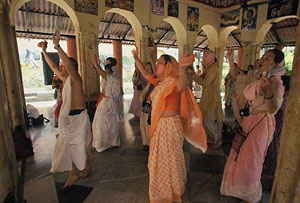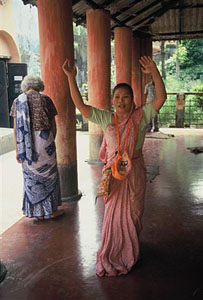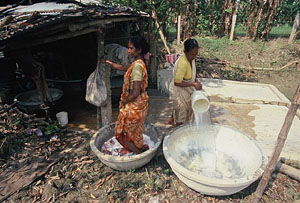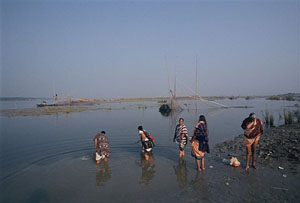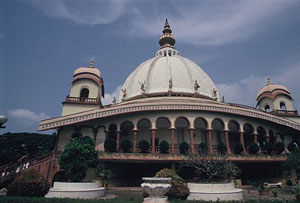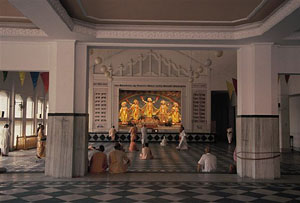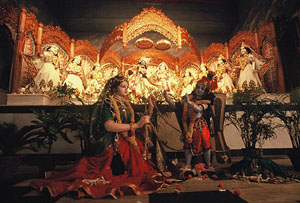 |
|||||
|
|
|||||
|
A Spiritual Journey to West Bengal
My story begins some years earlier in Wellington, New Zealand where my eldest daughter Karen began her relationship with the Hare Krishna movement. During the years that followed I found myself totally bewildered at both this new relationship and my lack of knowledge of what really lay behind the words "Hare Krishna". In October, 2006 I decided to meet my daughter in India and travel together to Mayapur in West Bengal where I hoped to learn a lot more about the Hare Krishna movement, its history and beliefs.
On the way my daughter and I noticed the considerable amount of water still lying around in the fields and villages. We
discussed the flood damage at Mayapur that Karen had heard about previously when some 2 weeks earlier the Indian
authorities had decided to open the dam gates known as the Farrakah Barrage in one of the upper Ganges River tributaries
close to the Bangladesh border in northern Bengal. The height of the rushing waters of the Ganges caused massive flooding in
the Mayapur area. Until the waters receded the local people and the Hare Krishna devotees used small boats to move around and get to the different buildings inside the complex. The Administration Office provided efficient check-in facilities for visitors allowing us to reach our room in the Vamsi (flute) building fairly quickly. We could finally relax. The complex is huge with 4 additional buildings including the Gada (club) building which houses the main reception area and dining facilities for up to 450 people at any one time. On the way to our room I noticed a mixture of different people, local Bengalis, a group of devotees from Taiwan and clearly foreign or western devotees all dressed in dhotis (a cotton loose-fitting wrap around and comfortable form of trousers worn by men) or in colorful saris (the women). The place radiated an atmosphere of peace and quiet. Everyone who passed us gave us the traditional welcome of Hare Krishna or Haribol. This warm and friendly greeting made me feel somewhat more comfortable in an environment still strange to me.
The previous name of Mayapur was Nadia or Navadvipa (in about 1486) and was considered a place of advanced learning. Nava means 9 and Dvipa means island, so it is referred to as the place of 9 islands. Mayapur is located on one of these islands at the junction of the Ganges and Jalangi rivers. One of the major contributions to the importance of Mayapur is due to Sri Chaitanya (1486 - 1534) who was born there. Chaitanya is considered an incarnation of God by the orthodox Gaudiya Vaishnavas (devotees of Vishnu), based on prophecies from the ancient Vedic scriptures and Hindu tradition. My daughter Karen or Krsna Lila (her spiritual name), provided me with some more important background information. 500 years before Gandhi, Sri Chaitanya became an important social reformer inaugurating a massive nonviolent civil-disobedience movement against the occupying Islamic government in India.
We were fortunate enough to be able to join a group of devotees and visit the original homes of both Bhaktisiddhanta and Bhaktivinode. These houses were well preserved as befitting their important historical nature with the owner's original furniture and utensils still in place. Nearby temples also offered a welcomed opportunity for the devotees to pray and subsequently listen to an explanation of the history of the surroundings. Inside each temple there were Deities, (which are, as I understand, representative forms of the Lord for purposes of worship) that remained protected behind wire screen doors which were opened at certain times for prayers. On one occasion that I vividly remember at the Temple of Gauri Das (a place visited by Lord Chaitanya) there was a large open space in front of the alter allowing the devotees to move around freely where they chanted and danced ecstatically to the beat of drums.
Karen told me that it was Bhaktisiddhanta who encouraged his disciple, Swami Prabhupada to travel to the west. In 1965, Srila Prabhupada, as he is called by his followers, sailed to the United States at the age of 69. In spite of arriving alone and penniless, within a year he founded the International Society for Krishna Consciousness known as ISKCON. This new religious movement gradually spread to every country in the world and today numbers some hundreds of thousands of full time members. ISKCON identifies itself with Hindu Vedic philosophy and Vaishnavism with its beliefs deeply rooted in the Hindu text Bhagavad Gita, the "Song of the Lord". Most mainstream Hindus accept the Hare Krishna as an authentic sect within Hinduism. The Hare Krishna devotees worship the Hindu God Krishna as the one Supreme God. Their goal is "Krishna Consciousness" and their central practice is the Hare Krishna mantra for which they are named. Hare Krishna, Hare Krishna, I was told by a devotee that this mantra expresses devotion to Krishna where Krishna and Rama refer to God himself and Hare to "the energy of God". The chanting is believed to bring about a higher state of consciousness when it is sung or during meditation.
The land on which the Mayapur complex is situated was acquired in the early 70's and consisted of some uncultivated rice fields. Today it consists of more than 2000 acres (about 8 sq. kilometers) of which 95% is agricultural used mostly to grow rice with the remainder developed for seasonal vegetables and flowers. The water table level is very high in Mayapur and as a result water is very accessible contributing to the growing of rice as a major source of food.
There are also 4 schools in the complex where boys and girls receive an education that is both secular and religious. These children are taught in English mainly by people from the West. It was here that we met Bhakti Vidya Purna Swami who comes from a Jewish American background, has spent some time in Israel and now prepares courses in religious topics together with philosophy. In spite of the rather limited time we could share, it was clear that here was a person of high integrity who had traveled a long way to find a spiritual framework in which he could live happily. Most students upon graduation have a number of work options that include being sent around the world to teach and propagate what they have learnt in Mayapur. Life is almost entirely self-contained within the complex with a number of small shops located on the inner wall near the main entrance selling traditional religious artifacts, clothes and food. Close to the important pharmacy and medical services there is a small restaurant (Govinda's) providing tasty food and is also a convenient meeting place. Everywhere I wandered I found people most friendly and helpful. During my exploration of the complex in search of material to photograph we would often stop by a booth opposite the memorial temple owned by a charming Bengali couple for both a short chat about life in the complex and a drink of sugar cane juice that they produced on the spot. On one occasion we were told of a devotee about 50 years old who had died during the night. He was to be cremated that day and in the meantime was lying on a stretcher near the memorial temple. Each eye was covered with a flower. A small group surrounded him chanting softly while paying their last respects. Although I did not know the person, I felt strangely moved by the way these people treated both death (of the body) and the surviving spirit of the dead person. I was unable to take any pictures due to my confused feelings.
One of the main contributions to the community in which the devotees live consists of food distribution to the local people. Once a week I noticed long queues of people lined up outside the complex and when I enquired regarding the reason, was proudly told of the fact that up to 2000 people get a full meal for 8 rupees (less than 1 Israeli Shekel). In addition there is free prasadam (sanctified food) available outside the entrance to the main temple every day at about noon. The distribution of cooked food also occurs in times of hardship such as during the yearly flooding of the Ganges River.
There are between 45,000 and 125,000 pilgrims visiting the Mayapur complex each month. Most pilgrims come for a day's visit from nearby towns within a 50km radius of Mayapur.
The second temple is known as the Mayapur Chandrodaya Mandir and is the main temple complex housing the Deities. Here most of the day to day religious practices take place. One evening Karen and I visited the temple where devotees were offering lamps in honor of Krishna as a child (Damodar). The two halls were packed with hundreds of people chanting devotional songs. The music was hypnotic and it seemed as if some of the devotees were in a trance as they prostrated themselves towards the Deities. From time to time they also approached the beautifully lit alter and Deities to pay their respects. The air was thick with the smell of incense. I felt privileged to be present at this very special occasion.
Before I realized it my two weeks at Mayapur were over. In this short time I felt that I had traveled to another world where people seemed very different with a personal value system that is in contrast to that of the West. The devotees expressed warmth, friendliness and respect both to each other and outsiders. I also experienced a sense of devotion, not only on a religious level but also to each other and to the community that they serve. As I sadly left my daughter and the Mayapur complex, I noticed the new flowers and shrubs that were already beginning to thrive. On my lengthy return home via Kolkatta and Delhi, I had ample time to recall the many colorful memories and consider a new perspective of the Hare Krishna Movement. For anybody interested in seeing another face of India, I would strongly recommend a visit to Mayapur. The authors can be contacted via the photographer's website at www.meyerimages.com. |
|
|
|
|
